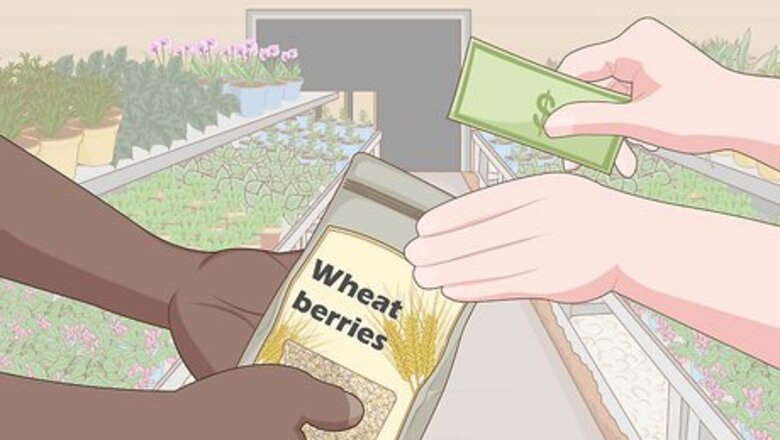
views
Sprouting the Seeds
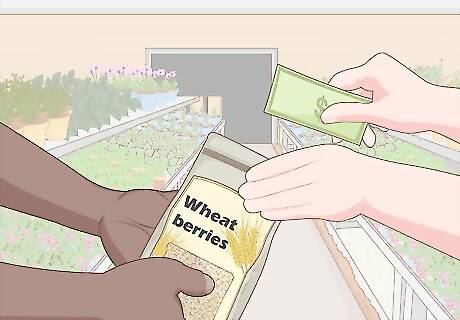
Purchase organic seeds in bulk from a reputable retailer. To help maximize the number of seeds that germinate, buy organic wheat berries from a quality nursery, health food store, or agricultural supplier. For best results, you’ll need to cover your growing medium with a thick carpet of seeds, so buy enough seeds for the number of trays you’ll plant.Choosing the right amount of seed: As a rule of thumb, use about 1 cup, or ½ lb (225 g), of wheatgrass seeds per 8 in (20 cm) of tray diameter. You can store seeds in a cool, dark, dry spot for up to 2 years, so spoilage isn’t a major concern if you buy, for instance, a 5 lb (2.3 kg) bag.
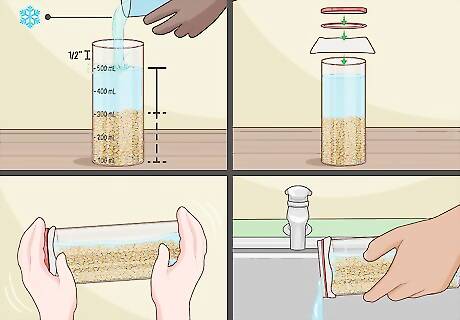
Rinse and drain the seeds before soaking them. Fill a large (pint or 500 mL) glass jar about halfway with seeds, then add cool, filtered water to about ⁄2 in (1.3 cm) below the rim. Cover the top with cheesecloth, secure the cloth with a rubber band or the jar’s collar ring, and cap the jar with its lid. Gently shake the jar for a few seconds to rinse the seeds, then remove the lid and drain the water through the cheesecloth. Preferably, use filtered water instead of tap to avoid introducing chemicals or microscopic organisms. If you don’t have cheesecloth handy, pour the water through a fine mesh strainer or colander. Catch the seeds in the strainer, then return them to the jar. Just make sure the holes are smaller than the seeds.
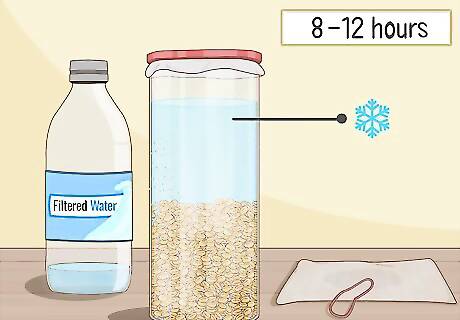
Soak the seeds in cool, filtered water for 8 to 12 hours. After thoroughly draining the rinse water, remove the cheesecloth and fill up the jar with fresh cool, filtered water. Replace the cheesecloth and rubber band (or the jar’s collar ring, if it has one), then soak the seeds for 8 to 12 hours. While they soak, keep the seeds at room temperature and out of direct sunlight.
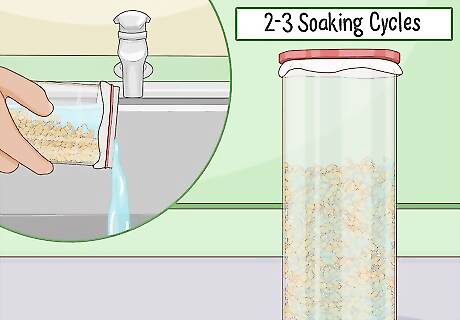
Complete 2 to 3 soaking cycles until small, white sprouts appear. After 8 to 12 hours, drain the water, fill the jar with fresh water, and repeat the soaking cycle. The seeds should grow larger in size, and you should see little white sprouts emerging from them after 2 to 3 cycles. If you don’t see sprouts after 3 cycles, drain the water and replace the jar’s lid. The jar should be drained, but you should keep the seeds moist; if necessary, mist them periodically. Let the seeds sit in the jar out of direct sunlight for about 12 hours, then you should see sprouts appear.
Transferring the Seeds to a Growing Medium
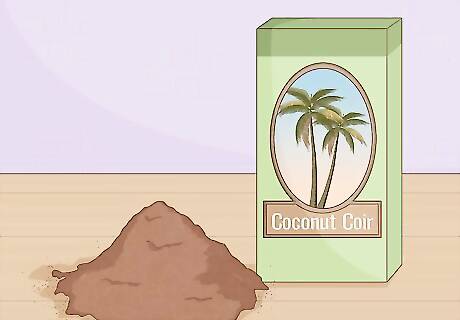
Grow your seeds in affordable, mold-resistant coconut coir. Find coconut coir online, at garden centers, and at agricultural suppliers. Coir is a fiber medium that’s often used as a soil alternative for microgreen cultivation. It retains water well, maintains a stable and neutral pH (which is important for wheatgrass sprouts), and is relatively inexpensive. Alternatively, you could mix equal parts of perlite and vermiculite if you want a less expensive growing medium or already have these soil alternatives handy. Cotton, hemp, and other natural fiber growing media are also available, but they tend to promote fungal growth.
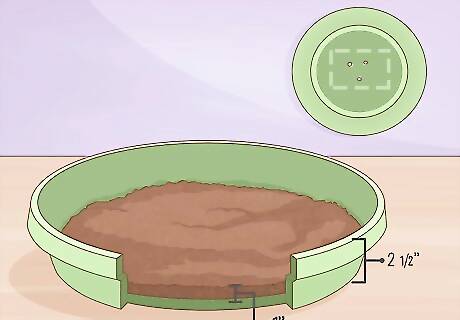
Cover a 2 ⁄2 in (6.4 cm) deep tray with 1 in (2.5 cm) of growing medium. Grow your wheatgrass in a shallow plastic or terracotta tray with at least 2 to 3 drainage holes. Your plants will only need a thin layer of medium, so just cover the bottom of the tray with about 1 in (2.5 cm) of coconut coir or other soil alternative. Spread the layer uniformly, but try not to pack it tightly. The sprout’s roots won’t spread well if the growing medium is too dense.
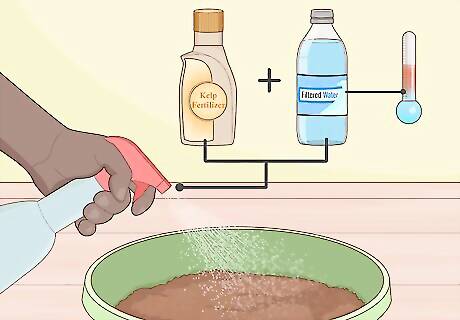
Moisten the growing medium with a mix of water and kelp fertilizer. Media such as coir and a mix of perlite and vermiculite aren't quite nutritious enough for wheatgrass, so adding fertilizer will help your plants thrive. Mix cool or lukewarm filtered water and liquid kelp fertilizer according to your product’s instructions, then spray the growing medium just enough to moisten it. Find liquid kelp fertilizer online or at a garden center. Mixing ratios vary, so check your product’s label for instructions and use it as directed. A general guideline is to use 1 fluid ounce (30 mL) of fertilizer per 1 gallon (3.8 L) of water. The growing medium should be damp, but not soggy. The sprouts will die if there’s standing water in the tray.
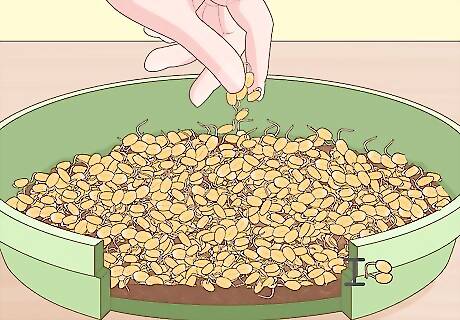
Spread the sprouted seeds over the medium in a dense, even layer. After moistening the growing medium, carefully sprinkle the seeds into the tray. Aim to completely cover the entire surface of the growing medium with a uniform layer about 2 seeds deep.Tip: Carefully shake the delicate sprouted seeds out of the jar, and try to avoid using your fingers. Be as gentle as possible if you do need to even out the layer of seeds by hand.
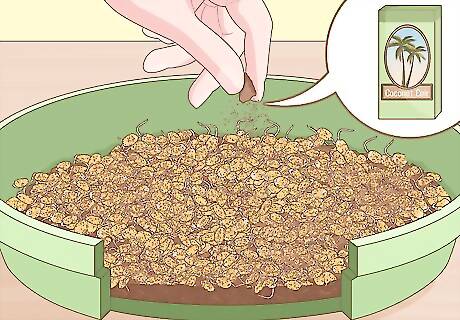
Sprinkle growing medium lightly over the seeds to partially cover them. Once you’ve spread the seeds, sprinkle a thin layer of additional growing medium over the tray. Don’t bury the seeds; just partially cover them with a light dusting of growing medium. Lightly dusting the seeds with growth medium will help keep them moist.
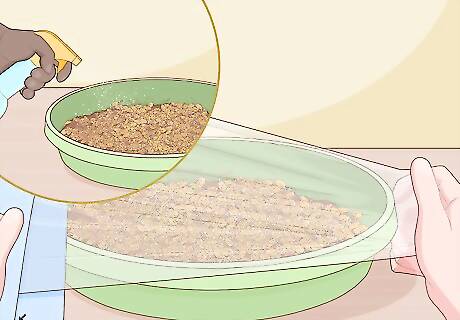
Mist the tray, then loosely cover it with plastic wrap. When you’ve finished partially covering the seeds, spray them lightly with more of the water and kelp fertilizer mixture. Then stretch a sheet of plastic wrap loosely over the tray to help prevent moisture from evaporating too quickly. Remember that the seeds don’t like soggy conditions, so just mist the tray lightly.
Caring for Your Sprouts
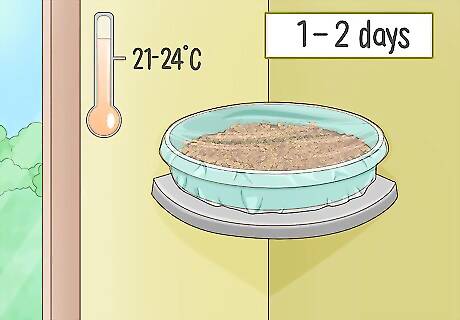
Keep the tray in a warm, shaded spot for 1 to 2 days. Room temperature or slightly warmer is best for germinating wheatgrass. Direct sunlight can hurt the sprouting seeds, so keep the nursery tray away from windows for the first couple of days. As long as you keep the temperature in your home around 70 to 75 °F (21 to 24 °C), you shouldn’t need a heat lamp or any other special equipment.
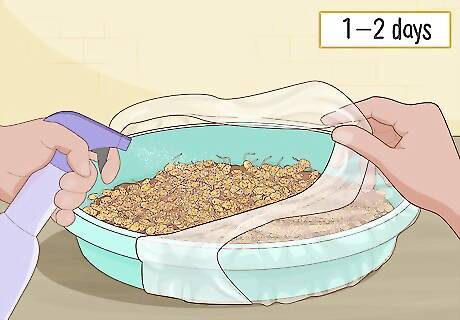
Water the tray just enough to keep the growing medium moist. Check the growing medium 1 to 2 times per day to make sure it’s slightly damp. If it starts to feel dry, mist it lightly with cool or lukewarm filtered water. You may need to mist the tray every 1 to 2 days to maintain a moist environment. Be sure not to water so much that the growing medium becomes soggy or water stands in the tray.
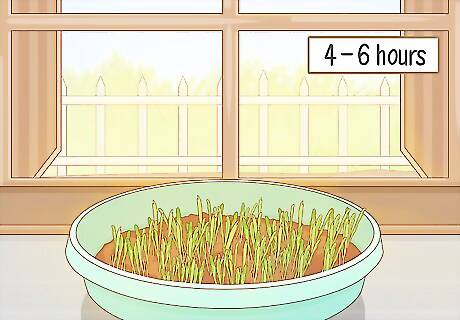
Move the tray to a brightly lit spot once green shoots appear. After 1 to 2 days, you should see tiny green shoots poking out from the growing medium. When that happens, remove and discard the plastic wrap, and place the tray by a window that gets at least 4 to 6 hours of sunlight. If you’re growing several trays of wheatgrass or don’t have a suitable window, you can also keep your seedlings under a 150-watt fluorescent lamp.
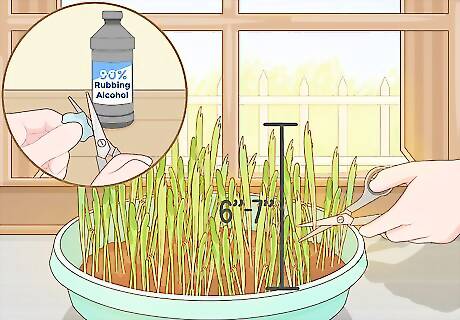
Harvest the grass when it’s about 6 to 7 in (15 to 18 cm) tall. The sprouts should be ready to clip about 8 to 10 days after planting. Cut them just above the level of the growing medium with a pair of sterilized scissors. To sterilize your scissors, wipe them with a paper towel soaked in 90% rubbing alcohol. Alternative, wipe them with a mixture of 10 parts water to 1 part bleach, then rinse away the bleach solution with hot water. Rinsing isn't necessary if you use the alcohol method. Sterilizing your scissors will help prevent disease and keep the wheatgrass healthy enough to grow back for a second clipping.
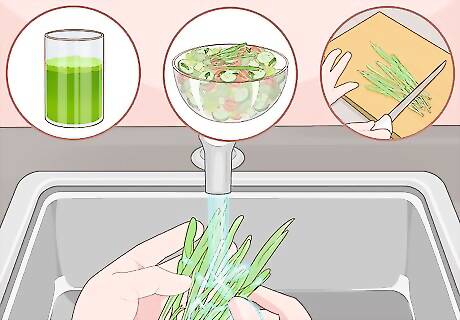
Wash and enjoy your harvested sprouts. Rinse your harvested wheatgrass under running water, then juice it or chop it and top soups and salads with it. After harvesting, refrigerate wheatgrass in a tightly sealed container for up to 7 days.Tip: After the first clipping, your wheatgrass will start to grow back, just like your lawn. You can continue to maintain the grass and clip it again after another 8 to 10 days. The nutritional value decreases with each clipping, so it’s best to compost or dispose of the tray’s contents after 2 clippings.

















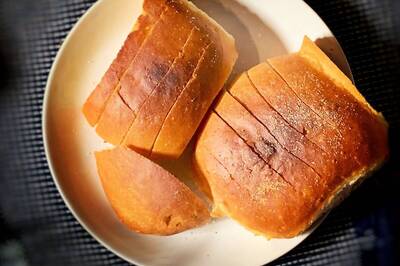
Comments
0 comment